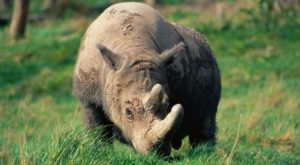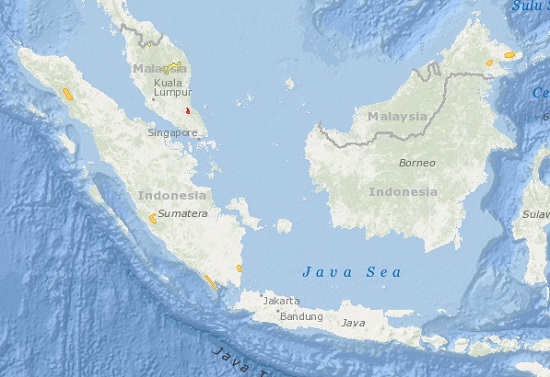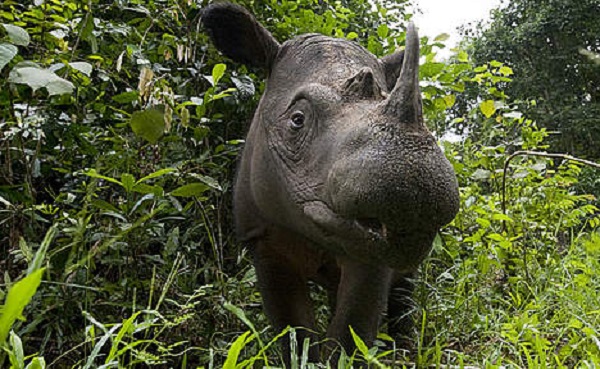Interesting Facts
- A calf born in the Cincinnati Zoo in Ohio was the first Sumatran Rhinoceros born in captivity in over 100 years.
- There are fewer than 250 Sumatran Rhinoceros in the wild, they are so endangered that they are one of the rarest large mammals in the world.
- There are five types of rhinoceros: Black, White, Javan, Indian and Sumatran rhinoceros. Javan and Sumatran Rhinos are critically endangered.
- Their horns are made of keratin, a protein found in hair and nails.
- Rhinos are killed for their horns which is used as traditional medicine or worn as ornaments.
Taxonomy

The Sumatran Rhino is the smallest of five types of rhinos.
- Kingdom: Animalia
- Phylum: Chordata
- Class: Mammalia
- Order: Perissodactyla
- Family: Rhinocerotidae
- Genus: Dicerorhinus
- Species: Dicerorhinus sumatrensis
o
o
Name
- Common Name: Sumatran Rhinoceros, Hairy Rhinoceros, Asian two-horned Rhinoceros.
- Scientific Name: Dicerorhinus sumatrensis from the Greek dicero meaning “two horns” and rhinus meaning “nose”, sumatrensis from the Latin for “from Sumatra”.
Population and Conservation Status
- It is estimated that there are fewer than 250 mature individuals in the wild. There are 20 animals in captivity in Malaysia, Indonesia and the United States.
- Its population is very fragmented and has experienced a decline of more than 80% over the last 60 years.
- Since 1996 the Sumatran Rhinoceros has been listed as Critically Endangered by the IUCN.
- This species is listed under Appendix I of CITES.
Habitat
- Sumatran Rhinoceros live in isolated pockets of mainly dense tropical protected forest, they usually wonder to secondary forest and forest margins. They prefer hilly areas close to sources of water moving uphill when the lowland floods.
- They live at a maximum altitude of 8,202 feet (2,500 meters) above sea level.
Distribution
- There are three subspecies of Sumatran Rhinoceros: Western Sumatran Rhinoceros (Dicerorhinus sumatrensis sumatriensis), Eastern Sumatran Rhinoceros (Dicerorhinus sumatrensis harrissoni) and Northern Sumatran Rhinoceros (Dicerorhinus sumatrensis lasiotis).
- The largest population of Sumatran Rhinoceros is the West Sumatran Rhinoceros subspecies with about 75 to 85 animals remaining in Bukit, Way Kambas and Gunung Leuser National Park in Sumatra, Indonesia.
- The Eastern Sumatran subspecies has about 50 individuals remaining and is found in Tabin National Park in Sabah, Malaysia.
- The population of Northern Sumatran Rhinoceros is unknown.
- This Sumatran Rhino is extinct in Bangladesh, Cambodia, Myanmar, Bhutan, India, Laos, Thailand and Vietnam where they were once plentiful.

Sumatran Rhino Distribution. Map adapted from IUCN Red List of Threatened Species
♦ Population possibly extinct ♦ Probably extant (resident) ♦ Extant (resident)
Physical Description
- The Sumatran Rhinoceros is the smallest and hairiest of all five living species of rhinoceros.They are closely related to the now extinct woolly rhinos than any other species alive today.
- Its skin is thick and leathery forming folds around its neck, between the legs and the trunk. In adults the skin is dark gray or brown and up to 0.59 in (15 mm) thick.
- It has two horns on the snout which are smaller than those of the African Rhinos. The larger one is the nasal or front horn measuring from 5.9 to 9.8 in (15 to 25 cm) on average and up to 31 in (79 cm). The posterior horn is 3.9 in (10 cm) on average. Horns are dark grey or black. Horns are made of keratin.
- They are born with dense hair that turns redish brown when they are about 6 years old. As they age their hair becomes black and bristly.
Size and Weight
- An adult Sumatran Rhino weights from 1,100 to 1,800 lbs (500 to 800 kg).
- They are 3.94 to 4.76 ft (1.2 to 1.45 m) standing at shoulder height and have a body length of 8.2 ft (2.5 m) on average.
Behavior
- This species is solitary except during mating and when mothers are rearing their young.
- Adult males have a homerange of up to 5,000 ha while females up to 1,500 ha. Females territories can overlap with that of males.
- They mark their territories with feces, urine and scrapes.
- They have an acute sense of smell and sharp hearing but their vision is poor.
- Sumatran Rhinos are herbivorous and browsers preferring fruits, leaves, young saplings, twigs and bark. Mangoes and figs are their preferred foods.
- The can consume up to 110 lb (50 kg) of food daily.
Reproduction
- Sexual maturity is reached at 6 years old for females and at 10 for males.
- Gestation lasts 15 months and females give birth to one calf at a time during the rainy season from October to May.
- Calves become independent at 16 months.
Life Expectancy
- Longevity is estimated at 35 to 40 years old.
Threats
- Habitat loss due to conversion of land to agriculture and human settlement.
- Poaching represents a major threat to the small population of Sumatran Rhinos. Rhino horns are used in Traditional Chinese Medicine as aphrodisiac and medicine fetching extremely high prices. They are also used as ornaments in some cultures.
- Inbreeding due to the small population and limited genetic pool.
- Sometimes rhinos invade agricultural land and feed on crops which makes local people see them as pest.
Reference and further research
- IUCN Red List of Threatened Species – Dicerorhinus sumatrensis
- University of Michigan Museum of Zoology – Sumatran Rhinoceros Dicerorhinus sumatrensis
- Borneo Rhino Alliance
- Rhino Resource Center- Sumatran Rhino
- International Rhino Foundation
- Convention on International Trade in Endangered Species of Wild Life and Flora (CITES)
- Cincinnati Zoo

